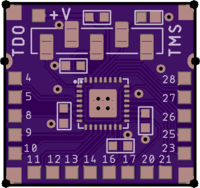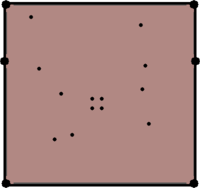-
Tested. Works.
03/10/2018 at 23:31 • 0 commentsThe PCBs arrived last night, but I had to wait for this morning for the box of parts from DigiKey - I almost got the timing right this time. Here's the assembled board with a Roman denarius for scale. It's pretty small. The #TinyFPGA Programmer is plugged in on top. It programs the FPGA just fine.
![]()
I was careful to apply just a little paste with a 25 Ga needle since I've been having issues with QFN packages. I still got 3 solder bridges I had to clean up with an iron, but otherwise it worked OK. I think my paste is getting old - it's probably two years old now and never been in the fridge (I can hear you cringing, people :-)
I wrote some quick test verilog just to make sure all the pins work, and they do.
Now, I can build a few more of these things and put them to use.
I think I'm going to make a composite video frame grabber as a test.
-
PCB: First Cut
03/01/2018 at 03:09 • 0 commentsSo, I threw together a quick breakout PCB for the MachXO2-1200 FPGA. The idea is that you mount it to a solid ground plane (un-etched copper clad) by soldering down the castellations on the edges, then connect it up with wire wrap (twisted pairs when needed).
![]()
![]()
The bottom has no soldermask, so it can make good contact with the ground plane. You could theoretically reflow it to the plane, but if you just tack-solder the 6 castellations, you could remove the PCB if desired.
The circuit is pretty simple: FPGA, bypass caps, and a 4k7 pulldown on the JTAG clock line I shamelessly stole from the TinyFPGA design. It presumably keeps the clock from toggling spontaneously and screwing things up. It's mostly solder pads, really. I added s 5-pin surface-mount header that's compatible with the TinyFPGA programmer.
![]()
I've sent design to OSH Park, and now just have to wait.In case anyone is wondering what this is all about, here's another project I made with similar boards:
![]()
 Ted Yapo
Ted Yapo



